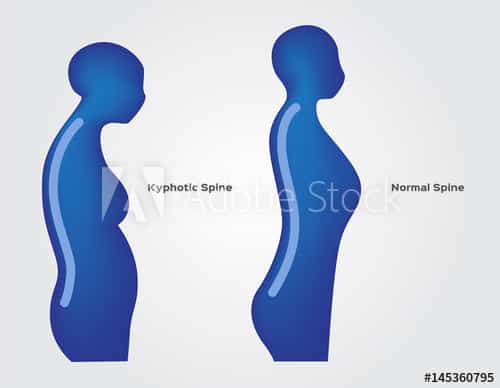Are you noticing a hump forming on your spine? Is your head a little in front of your shoulders?
Hyperkyphosis is the condition that causes the hump and general stooping. Whether you’re afraid of developing hyperkyphosis or aging has already begun the progression of the condition, it’s time to fight back! When hyperkyphosis is not treated, you may start having trouble performing ordinary tasks like bending, bathing, getting out of a chair or even walking.

The spine comprises three regions – cervical, thoracic, and lumbar – and each area has a natural curve. Kyphosis occurs naturally in the thoracic portion of the spine, which is in the middle and includes your ribs and chest plate. Hyperkyphosis exaggerates that curve. Occurring commonly with advanced aging, hyperkyphosis is associated with low bone mass, vertebral compression fractures and degenerative disc disease.
Hunchback harm
A hunchback posture:
- Interferes with the ability to stand erect and maintain normal spinal alignment.
- Can make some problems worse, such as a stiff neck, vision issues and sore shoulders.
- Compromises balance, increasing the risk for a fall.
- Slows walking speed.
- Makes it harder to walk stairs.
- Increases the risk of fractures. in fact, women with hyperkyphosis have a 70% increased risk of a future fracture, and the risk increases as the condition progresses.
Prevention for hunchback
Early acknowledgement of, and treatment for, this pattern can help you reduce your risk for falls and fractures while helping you to maintain or improve your current level of activity. A physical therapist can evaluate your risk and design a training program to treat or prevent hyperkyphosis. The three videos here demonstrate the types of exercises we prescribe at Heather Lane Physical Therapy.
Citations:
Ferrucci L, Bandinelli S, Cavazzini C, et al. Neurological examination findings to predict limitations in mobility and falls in older persons without a history of neurological disease. Am J Med. 2004;116:807-815.
Huang MH, Barrett-Connor E, Greendale GA, Kado DM. Hyperkyphotic posture and risk of future osteoporotic fractures: the Rancho Bernardo study. J Bone Miner Res. 2006;21:419-423. http://dx.doi.org/10.1359/JBMR.051201
Kado DM, Huang MH, Nguyen CB, Barrett-Connor E, Greendale GA. Hyperkyphotic posture and risk of injurious falls in older persons: the Rancho Bernardo Study. J Gerontol A Biol Sci Med Sci. 2007;62:652-657.

